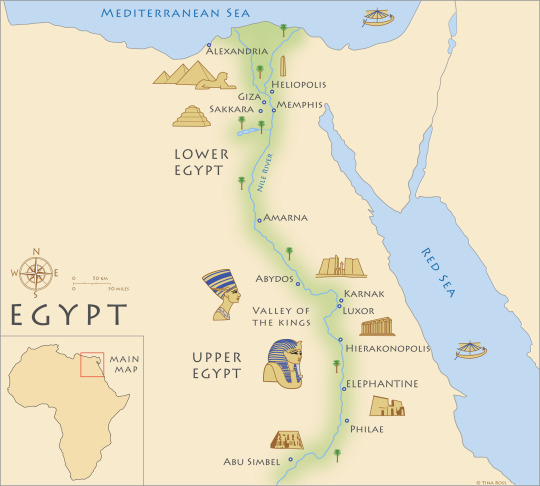Text
TABLE OF CONTENT / HOW TO NAVIGATE

this blog contains 9 posts. Each post containing pictures, videos, links, etc about the posts topic. Sentences ending in a small number references a reference, which can be found in the citation page.
HOW TO READ: this blog reads like an essay. With the intro paragraph at the top of the blog, the body being the posts, and the conclusion and citation page at the bottom of the blog.
select the more to open the post
comments can be left by scrolling to the bottom of each post, selecting the speech bubble icon, and simply leaving a comment.
TABLE OF CONTENT
intro
map of ancient Egypt
timeline of ancient Egypt
religion
food
Ramses II
Tomb of Nebamun Frescos and all about Zahi Abbas Hawass
conclusion
citations
0 notes
Text
INTRO

One of my fondest memories in middle school was sitting in my 6th-grade history class during a segment on ancient Egypt. My teacher, Mrs. Johnson, would bring out examples of papyrus and lapis lazuli, copies of artworks and glyphs, and even jars filled with real sand and dirt from the sites of pyramids or crypts. I was fascinated, completely in awe that something this ancient, this otherworldly even, actually existed. The aesthetic, the history and culture of ancient Egypt, struck a chord in me so deep that the sound of my fascination resonated within me long after that class, and middle school itself, ended. I found myself watching countless documentaries and reading stories of those ancient times. From the history of Pharaohs to the daily lives of the peasant class, every aspect of ancient Egyptian culture fascinated me. As I read the stories of these ancient people and metaphorically walked in their footsteps, I felt a deep sense of connection.
As I watched the documentaries and read the stories, I didn't just discover tales about ancient myths or the luxurious lives of Pharaohs; I also discovered the familiar and the common struggles of ordinary people, just like you and me. Of farmers tending to their crops, artisans crafting jewelry or making pots and pans to sell in the marketplace, of religious people participating in rituals or prayers, hoping and praying for better days. It all felt so familiar, so comforting, and I knew then and there that this middle school fascination with Egypt was much more than a simple obsession. It was home to me.
In saying all this, I'd like to share a little slice of home with you, with the hopes that I can only do justice to what is so much more than simple stories or artifacts. It's the lives of real people, people who lived and breathed and had stories of their own to share. People who walked, talked and lived normal lives like you and I. I hope that through the few posts on this blog, you'll be able to see the same depth and richness I've discovered.
0 notes
Text
RELIGION

Ancient Egyptian was a polytheistic culture. This means that they believed in many (poly) gods and goddesses (theis). This belief in multiple deities shaped every aspect of their lives, from daily rituals to even a societal level. Religiosity was deeply woven into their culture, and it was often thought that the only way to achieve success in life was through the favor of the gods. But what made Egyptian religion unique is that there were many aspects to the pantheon. It included gods with many different roles for everything in the universe, to minor deities, even foreign gods or humans (deceased pharaohs).1
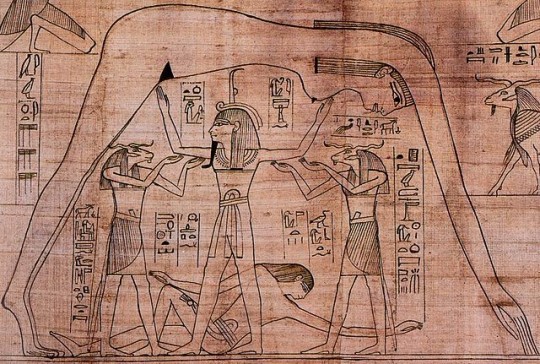
8
Much like how Catholics view the Pope as an intermediary between God and man, the pharaoh was also viewed in such a light. The role of the pharaoh was to maintain harmony in society and preserve and fulfill the god-given order, called the Ma’at. Upon his death, the pharaoh would become fully deified, able to be called upon by his past citizens for guidance in all aspects of life.2

6
Ma’at was an important concept in Egyptian religion. Meaning many different things like truth, justice, and order, Ma’at was considered to be the sort of center of the university, and vital to its survivability (without it, the world would crumble). Egyptians believed that their lives on earth were only just the start. While on earth, they were to uphold the values of Ma’at, so that when their time came, they would be entered into the Hall of Truth after death and be given an easy judgment by Osiris, the god of the dead. Egyptians also believed in a flat earth, called the god Geb. Over this flat earth arched the sky (goddess Nut), separated only by air (the god Shu). Underneath the earth was the underworld, and beyond the skies lay Nu, the chaos before creation.3 The Duat was a mysterious area associated with death and rebirth, and each day the sun god Ra passed through the Duat after traveling over the earth during the day. 4
watch this fun video explaining more about ancient Egyptian religion! ➡️ 🐫
When it comes to the impact of religion on the lives of everyday citizens, it was huge. Egyptians believed that the earth reflected the heavens. That the stars and planets all had meaning, and had a direct influence over one's personality or destiny. Not only that, but one of the pillars of Egyptian faith was harmony and gratitude, so much so that ingratitude was considered to be a sort of ‘gateway sin’, because it disrupted the harmony within one's soul and environment, allowing for the possibility of other sins to be committed.
Egyptians also liked to show their devotion through festivals. The nature of these festivals was to gather and worship as a community. These festivals (known as heb) were ways for citizens to give thanks for blessings, make more divine requests, make sacrifices in the gods' names, and plenty more.
Another well-known aspect is how the Egyptians buried their dead. Burial rituals were distinct and arduous, and as one can imagine, very dramatic.7 A quote from Herodotus, a greek history who lived from l. c. 484 – 425/413 BCE, recounts of the burial process: ‘As regards mourning and funerals, when a distinguished man dies, all the women of the household plaster their heads and faces with mud, then, leaving the body indoors, perambulate the town with the dead man's relatives, their dresses fastened with a girdle, and beat their bared breasts. The men too, for their part, follow the same procedure, wearing a girdle and beating themselves like the women. The ceremony is over, they take the body to be mummified.’ 5
0 notes
Text
FOOD

Historical documents show that the Egyptian diet consisted mainly of what are called staple foods, like whole wheat bread, beans, barley, cereals, vegetables, and fruits. And although the peasant class was largely vegetarian by circumstance, meat was still consumed, although usually reserved for special occasions and the wealthy upclass. 9

Ancient Egyptian food painting found in the Tomb of Menna, a high-ranking official during Egypt’s New Kingdom over 3,000 years ago when Amenhotep III was the Pharaoh of Egypt. 10
They prepared food through several cooking methods such as frying, grilling, roasting, stewing, baking, and boiling. Something unique about Egyptian culture at the time was that women were not the only ones who did the cooking. Men participated too. 10
Ancient Egyptian food is still being consumed today! Although some of the ingredients have changed due to circumstance, the names and spirit of ancient Egyptian food is alive and well to this day! 9

man offering foreleg of ox 11
0 notes
Text
RAMSES II

Ramses II was the third king in the 19th dynasty of ancient Egypt. Name meaning Keeper of the Harmony and Balance, Strong in Right, Elect of Ra, ect, his rule was the second longest in Egyptian history. Ramses II was mostly known for his victory of the Hitties at The Battle of Kadesh, as well as being the well known pharaoh spoken about in the Bible and the Quran.12
Ramses was the son of Queen Tuya and Seri I. As a young boy, Ramses would accompany his father on military expeditions near Libya and Palestine.12 By the time he reached adulthood, he was leading his own expedition through Nubia with his own sons.
After the death of his own father, Ramses assumed the throne as the third king in the 19th dynasty. He began plans to restore the borders of Egypt, ensure trade opportunities, and fight back against the encroaching Hittites. 14
His most well known battle, the Battle of Kadesh, was what really cemented Ramses into the books of history. His army marched for two months before he settled into his strategic positioning. His people had captured two Hittite soldiers and, after some intense interrogation methods, received the knowledge of where the Hittite army was located. After intense battle and many switches of strategy, Ramses claimed victory over the Hittites, but not after a great loss to his forces and his near death. 14
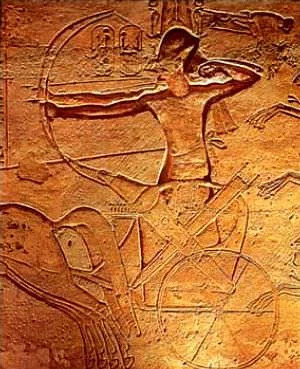
Ramses at the Battle of Kadesh 13
Ramses was known for the construction of hundreds of temples, monuments, and other great structures. So much so that his reign was considered the pinnacle of Egyptian art and culture. His famous Tomb of Nefertari was the most well known. Nefertari being his first and favorite queen, her depiction is scattered throughout the walls of temples and artworks. Even after her death, he continued to depict her likeness throughout his chambers and construction. 12
Ramses reign was considered to be somewhat arguable, in that some scholars believed him to be more of a performer or entertainer than an actual king. But records of his reign show that during the era of his reign, Egypt was prosperous! He secured Egypts borders during the Battle of Kadesh and beyond, increased its wealth, and extended its trade routes. Ramses was considered one of the better rulers, but would never reach the same status as Ramses the Great in the history of ancient Egypt. 12
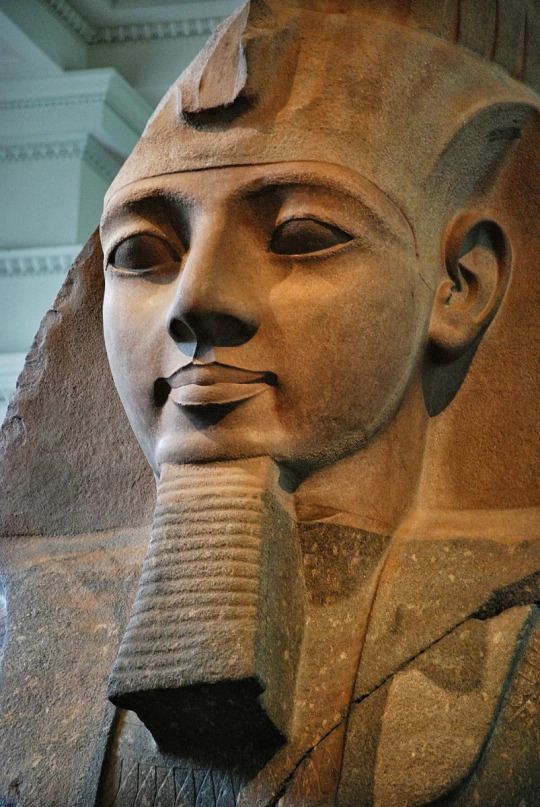
0 notes
Text
TOMB OF NEBAMUN FRESCOS /DR. ZAHI HAWASS

The Tomb of Nebamun Frescos references the exquisite art and details decorating the tomb of Nebamun, a middle ranking official scribe and grain accountant during the period of the New Kingdom in ancient Egypt. The paintings seem to show a sorta Idealized version of daily Egyptian life in that time period, showing experiences of both the rich and the poor. The frescoes depict Nebamun in all aspects of life, of him hunting in the marshes, his garden, his cattle, surveying the fields as the grain accountant, and much more. It seems like Nebamun wanted to depict and capture his life for his future successors and family to see. How similar Nebamun was to us! 17
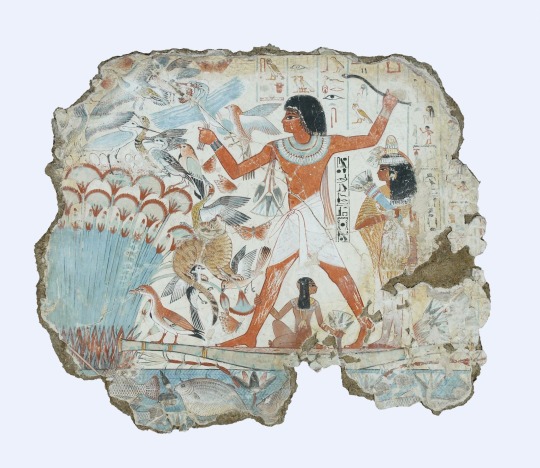
Nebamun hunting in the marshes 18
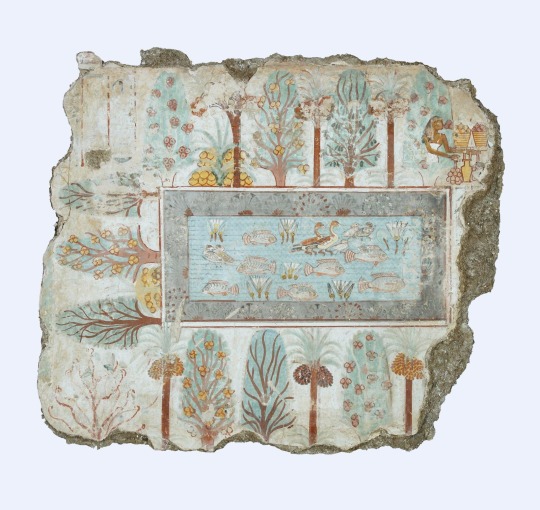
his garden 18

surveying his fields 18
DR. ZAHI HAWASS
Zahi Hawass is considered to be the most prolific Egyptologist there is. Along with being the former Minister of State for Antiquities Affairs (serving twice), Hawass worked and led many archaeological sites along the Nile Delta, Western Desert and Upper Nile Valley. 15
Hawass was born in a small village in Damietta, Egypt. He had originally dreamed of becoming an attorney, but switched career paths after earning a degree in Arts in Greek and Roman Archaeology from Alexandria University in 1967. Afterwards, Hawass earned a diploma in Egyptology from the prestigious Cairo University. He then went on to work at the Great Pyramids as an inspector—a combination of administrator and archaeologist.16

16
0 notes
Text
CONCLUSION

As we conclude our journey through ancient Egypt, I hope you can understand why I previously called this place my home. It's my childhood in Mrs. Johnson's class, holding a soft rock of lapis, running my fingers gently through a scroll of papyrus. And it's also my current state, writing a blog about it who knows how many years later, recalling all that I've learned and loved. But above all, I want to emphasize why it's important (or should be important) to you.
Although there are aspects of ancient Egyptian culture that sound bizarre or unfamiliar, I want to highlight a key point on its importance, and that is that ancient Egypt was a population of people just like you and me. And that might set off alarm bells in your head. Because we don't have burial rituals or participate in festivals dedicated to our respective gods. We don't worship a pharaoh or any number of other bizarre things the Egyptians did. But I want to counter that and say we do indeed share the same characteristics. When we gather our loved ones and dress our deceased in their Sunday best, sing songs, and have feasts in their names, that's a burial ritual. When we participate in festivals dedicated to our gods. When we gather on Sundays to sing songs or congregate in Eid prayers and festivities, those are festivals just like the Egyptians did. We do all sorts of similar things that the Egyptians did because we are no different from them. It's not just the history of Egyptians; it's the history of humanity. Of you and me. That's why this is so important for anybody to learn. Because we are living in the legacy of ancient Egypt right now. And our children will do the same, and their children to come, and so on and so forth.
Studying the past isn't just about studying boring facts about long-dead people we will never meet or know; it's about studying ourselves. About studying humanity. Doing this can often help us understand our lives in the here and now. And help us navigate life. Because all in all, someone else has lived through our situation, some thousands of years ago, near the banks of the river Nile, and their stories, their struggles, their triumphs, resonate through time to guide us. By delving into the past, we uncover the ties that connect us to those who came before, gaining insight into the human experience and finding peace and comfort in the knowledge that we are part of a continuum of existence. And so, as I conclude this blog, lets us reflect on our own place in the timeline of history, and the interconnectedness of it all.

0 notes
Text
CITATIONS

1 Boundless. (2019). Ancient Egyptian Religion | World Civilization. Lumenlearning.com.
https://courses.lumenlearning.com/suny-hccc-worldcivilization/chapter/ancient-egyptian-religion/
2 National Geographic. (2022, May 20). Pharaohs | National Geographic Society. Education.nationalgeographic.org. https://education.nationalgeographic.org/resource/pharaohs/
3 Mark, J. J. (2016, January 20). Ancient Egyptian Religion. World History Encyclopedia; World History Encyclopedia. https://www.worldhistory.org/Egyptian_Religion/
4 Digital Giza. (n.d.). Digital Giza | Daily Life in Ancient Egypt. Giza.fas.harvard.edu. http://giza.fas.harvard.edu/lessons/ancient-egyptian-religion
5 Mark, J. (2013, January 19). Ancient Egyptian Burial. World History Encyclopedia; World History Encyclopedia. https://www.worldhistory.org/Egyptian_Burial/
6 Rosicrucian Egyptian Museum. (2022). Ma’at- Explore Deities of Ancient Egypt. Egyptianmuseum.org. https://egyptianmuseum.org/deities-Maat
7 LibGuides: Ancient Egypt: Gods, Afterlife, & Burial Traditions. (2016). Vic.edu.au. https://libguides.stalbanssc.vic.edu.au/ancient-egypt/religion
8 https://en.m.wikipedia.org/wiki/File:Geb,_Nut,_Shu.jpg
9 Halawa, A. (2023). Influence of the traditional food culture of ancient Egypt on the transition of cuisine and food culture of contemporary Egypt. Journal of Ethnic Foods, 10(1). https://doi.org/10.1186/s42779-023-00177-4
10 Adham, S. (2022, January 7). Ancient Egyptian Cuisine. En.majalla.com. https://en.majalla.com/node/190491/cultureancient-egyptian-cuisine
11 Stèle de bkaou. (2033, April 1). Musée Du Louvre. https://collections.louvre.fr/en/ark:/53355/cl010037481
12 Mark, J. J. (2009, September 2). Ramesses II. World History Encyclopedia. https://www.worldhistory.org/Ramesses_II/
13 Ramesses II at The Battle of Kadesh. (n.d.). World History Encyclopedia. https://www.worldhistory.org/image/1006/ramesses-ii-at-the-battle-of-kadesh/
14 Rattini, K. (2019, May 13). Who was Ramses II? Culture; National Geographic. https://www.nationalgeographic.com/culture/article/ramses-ii
15 Wikipedia Contributors. (2019, November 30). Zahi Hawass. Wikipedia; Wikimedia Foundation. https://en.wikipedia.org/wiki/Zahi_Hawass
16 Hammer, J. (2013, June). The Rise and Fall and Rise of Zahi Hawass. Smithsonian; Smithsonian.com. https://www.smithsonianmag.com/history/the-rise-and-fall-and-rise-of-zahi-hawass-72874123/
17 Egyptian life and death | British Museum. (n.d.). Www.britishmuseum.org. Retrieved May 10, 2024, from https://www.britishmuseum.org/collection/galleries/egyptian-life-and-death#:~:text=Ancient%20Egyptian%20life-
18 Paintings from the Tomb-chapel of Nebamun (article). (n.d.). Khan Academy. https://www.khanacademy.org/humanities/ancient-art-civilizations/egypt-art/x7e914f5b:new-kingdom-third-intermediate-period/a/paintings-from-the-tomb-chapel-of-nebamun
1 note
·
View note
